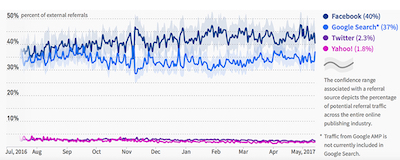Publishers routinely spend a dizzying amount of time refining and retooling algorithms in an attempt to improve search engine optimization, but do they ever consider how an article’s subject matter influences where readers are likely to find it?
A recent analysis of more than 10 million online articles by technology company Parse.ly sheds some light on how readers find their way to articles on the Internet. As it turns out, an article’s likely referral sources vary widely depending on its subject, and understanding where audiences are most likely to stumble upon a particular story offers invaluable insights to publishers and marketers looking to drive readership and improve visibility.
 |
For example, articles focusing on entertainment get an inordinate amount of their traffic from Facebook, accounting for 61 percent of external referrer traffic versus Google search, at 29 percent. For articles focusing on lifestyle, the scales are even more unbalanced, drawing 87 percent of their external traffic from Facebook, versus only about seven percent from Google. Similar trends can be seen in articles focusing on education and U.S. presidential politics, which both receive 59 percent of their traffic from Facebook versus 21 and 25 percent from Google, respectively.
On the other hand, articles pertaining to the world economy see 43 percent of their external traffic originate from Google searches while only 36 percent of their traffic come from Facebook; articles specializing in technology get 61 percent of their traffic from Google and 21 percent from Facebook; sports stories achieve 50 percent of their traffic from Google and 19 percent from Facebook; and business stories net 47 percent of their traffic from Google versus 14 percent from Facebook.
Google especially leads in job postings, driving 84 percent of all traffic to content focusing on this subject, versus only 12 percent for Facebook.
According to Parse.ly, Facebook is now the largest source of external referrer traffic, accounting for 39 percent of all known external traffic last year, compared to Google’s 35 percent (Twitter accounted for a distant third, at 10 percent.). In May, the top sources by external referral were Facebook (40 percent), Google (37 percent), Twitter (2.3 percent) and Yahoo! (1.8 percent).
The findings were based on Parse.ly’s analysis of 10,020,061 articles that were published last year by news outlets within the company’s network.



 Have a comment? Send it to
Have a comment? Send it to 
No comments have been submitted for this story yet.